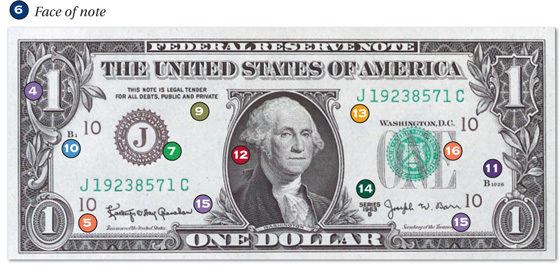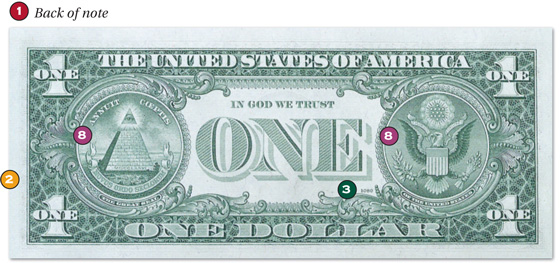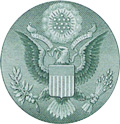$1 Federal Reserve Notes Collection
The $1 Federal Reserve Note Design
As the largest – and only current – issue of modern U.S. currency, Federal Reserve Notes (FRNs) are well known across the United States. Approximately 2-4 billion $1 notes are issued each year, making them the most printed denomination. And though most modern paper money denominations have undergone major redesigns, there are currently no plans to change the $1 FRN. Yet there's so much more behind this popular design...
How well do you know your paper money?
The very first $1 Federal Reserve Note design was issued for Series 1963, featuring the same bold portrait of George Washington still shown on today's notes. A number of different elements add to the uniqueness and beauty of each Federal Reserve Note design. Below, we've labeled the anatomy of a $1 Federal Reserve Note... how many elements are new to you?


-
 Back
Back -
 Border
Border -
 Check Number
Check Number -
 Denomination
Denomination -
 District Number
District Number
-
 Face
Face -
 Federal Reserve District Seal
Federal Reserve District Seal -
 Great Seal
Great Seal -
 Obligation
Obligation -
 Plate Position Number
Plate Position Number -
 Plate Serial Number
Plate Serial Number
-
 Portrait
Portrait -
 Serial Number
Serial Number -
 Series Date
Series Date -
 Signature
Signature -
 Treasury Seal
Treasury Seal
 Back
Back- This is the preferred term for the reverse side of a paper note.
 Border
Border- The outer edge of the design on either the face or back of a note where the design ends and the plain currency paper outer margin begins.

The check number is used to cross reference plate numbers on the note's face.
 Check Number
Check Number- A small number found at the lower right of the back of a note, used to cross-reference with plate numbers on the face of the note. Check Number is the correct term for Back Plate Number.
 Denomination
Denomination- The face value or amount of money a coin or note is worth.

The District Number is represented by 10
 District Number
District Number- The Federal Reserve District Number appears four times on the face of a bill for identification purposes and corresponds with the letter in the District Seal to designate the Federal Reserve Bank that issued the note.
 Face
Face- This is the preferred term for the front side of a paper note.

 Federal Reserve District Seal
Federal Reserve District Seal- Found to the left of the portrait on the face of a note, the seal identifies the Federal Reserve Bank (there are 12) that issued the note.

 Great Seal
Great Seal- Established as the national emblem in 1782, it first appeared on U.S. paper money in 1907. Since 1935, it has been part of the back design of the $1 bill. On the obverse of the seal, the American eagle holds olive branches in its right talon and arrows in its left, under 13 stars for the original colonies. On the seal's reverse, a broken pyramid signifies strength, with room to expand.

 Obligation
Obligation- Legal Tender issued by the federal government is a promissory note; the government is required, or obligated, to honor it as legal currency. The actual written obligation (current notes state THIS NOTE IS LEGAL TENDER FOR ALL DEBTS, PUBLIC AND PRIVATE) appears on each note. The location and wording varies by series and type.

 Plate Position Number
Plate Position Number- Also called the Check Letter, it's the small capital letter (and sometimes number) that appears in the upper left corner of a note indicating the specific location of this note on the printing plate.

 Plate Serial Number
Plate Serial Number- The small number at the lower right of a note's face; identifies the printing plate from which the note was produced.
 Portrait
Portrait- Artwork depicting a real or fictional person on currency. Beginning in 1929, the U.S. government instituted a system of standardized portraits of notable Americans on specific denominations. Portraits were difficult to reproduce and readily identifiable to the public, making them effective anti-counterfeiting measures.

 Serial Number
Serial Number- Identifying number that appears twice on the face of a note. Used primarily to thwart counterfeiters, it also allows the Treasury Department to track production and distribution of notes.

 Series Date
Series Date- The date that appears on U.S. paper money, which unlike U.S. coins, does not represent the date the notes were printed. On paper money, the date changes only when changes are authorized or a new Treasury Secretary takes office.

caption
 Signature
Signature- U.S. paper money issues are promissory notes, currently signed by the Treasurer of the United States and the Secretary of the Treasury. Notes were hand signed until 1863; then facsimiles of signatures were printed directly on the notes. National Bank Notes required four signatures.

Treasury Seal shown here in green behind the ONE
 Treasury Seal
Treasury Seal- An emblem of the United States Treasury, a symbol that the currency is legally produced; printed on all notes, except for some Fractional Currency and the Demand Notes of 1861.
Read more...

